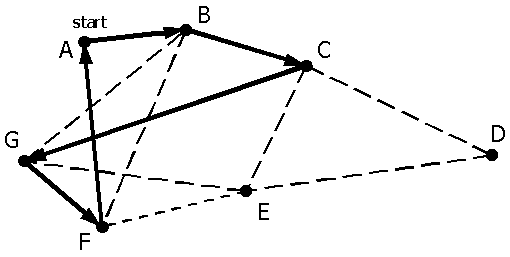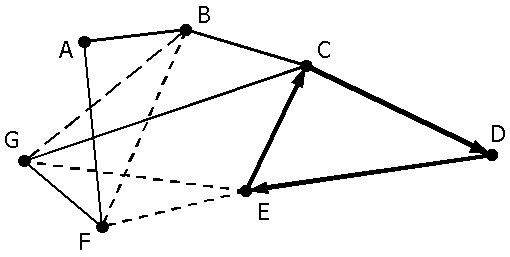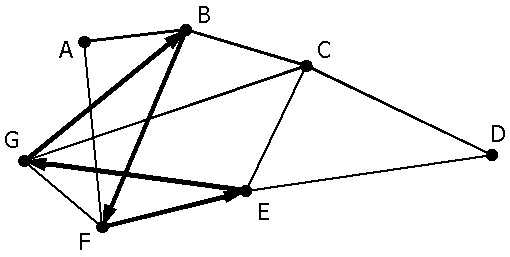 Lesson 12: Eulerian Paths and Circuits
Lesson 12: Eulerian Paths and Circuits

Motivation:
Consider a network of roads, for example. If it is possible to walk on each road in the network exactly once (without magically transporting between junctions) then we say that the network of roads has an Eulerian Path (if the starting and ending locations on an Eulerian Path are the same, we say the network has an Eulerian Circuit). This activity examines the characteristics of such paths and circuits. We study this problem because it is a classic example of the kind of problem computers are particularly good at solving.Materials:
- Bridges of Konigsberg tarp or chalk on the grass or tape on the floor.
- Bridges of Konigsberg overhead including overlays (1, 2, 3, 4) of vertices and edges (optional).
- Bridges of Eulertown overhead including overlays of vertices and edges (optional).
- Pencil puzzles - one copy per student.
Lesson Plan:
- Explain the story: The town of Konigsberg, Prussia was divided into four sections by the branches of the Pregel River. In the 18th century seven bridges connected these regions as pictured at the end of this lesson. The townspeople took long walks through the town on Sundays. They wondered whether it was possible to start at some location in the town, travel across all the bridges without crossing any bridge twice, and return to the starting point.
- Challenge the students to cross all 7 bridges exactly once, using the enlarged version of the bridges (on a tarp or grass).
- Show the Bridges of Konigsberg overhead (or draw the picture on the chalkboard), and make sure the students recognize that it's the same picture they saw on the tarp or grass. Show how the Bridges can be represented using a graph. If you completed Lesson 10 (Graphs) ask the students how they think the problem should be represented. Answer: Each land region is a vertex (also called a node), and the bridges are edges (also known as arcs). If you have the overheads, use them to demonstrate the representation, with vertices representing the land masses and edges representing the bridges. If you don't have the overheads, show on the chalkboard how to "shrink" each land mass into a vertex, and thin the bridges until they become edges. Now the Bridges problem becomes: "Is it possible to pass over each edge exactly once and return to the starting vertex?" This is the same as asking: "Is there an Eulerian Circuit?" (after Leonhard Euler (pronounced "oiler"), who was a prolific mathematician, the "father" of graph theory, and the first to solve this puzzle). Once you are sure all students understand the graph and problem, remove the original picture and just talk about the graph.
-
Discussion: how can we tell if there isn't an Eulerian Circuit? To
help them think about the answer, pick a room in your building
(excluding the room that you are in) that has one door (e.g., a
bathroom or small office) and ask them how many times they have been
through the doorway. When they say "who knows", tell them that even
if you don't know what a number is, you can often still tell some
things about it: Ask whether they've been through the doorway an odd
or an even number of times. Help them discover that the answer must
be "even" because if it was "odd", they'd be in that room right now!
Now relate this to the current problem: Think of the edges leading to/from a vertex as doors. If you start at vertex A, and cross each edge once and arrive back to A for the last time, how many times in/out of some other vertex B have you gone? Must be an EVEN number of times - otherwise you would still be at B. So, every vertex except A must have even degree -- that is, an even number of edges connecting to it. How about vertex A? It must also have even degree if there is an Eulerian Circuit; lets count the number of edges connecting to it: You start at A and leave along some single edge (an odd number of edges used so far, since "1" is odd), and then each time you re-enter and re-exit you use up 2 more edges (adding 2 to an odd number keeps it odd), and finally, you re-enter for a last time, make the number of edges you've crossed that are connected to A even. More succinctly, each vertex must be entered and then left again as the edges are traversed, except for the starting vertex which is left and then eventually re-entered. Summarize by saying "There is no circuit if any vertex has an odd number of edges."
- Given this discussion, ask the students if there is an Eulerian Circuit for the Bridges graph. NO!
- Next place the Eulertown graph on the overhead (or, draw it on the chalkboard) and ask if there is an Eulerian Circuit. The students should count vertex degrees and say, "NO!", since two vertices have odd degree.
- Take your overhead pen or chalk, and starting at a vertex of odd degree, trace the edges, going over each one exactly once. Ask the students to explain what happened. The answer is that there is no CIRCUIT, but there is a PATH! An Eulerian Path is almost exactly like an Eulerian Circuit, except you don't have to finish where you started. There is an Eulerian Path if there are exactly two vertices with an odd number of edges. The odd vertices mark the start and end of the path.
- More discussion: if every vertex has an even number of edges, is there necessarily an Eulerian Circuit? If there are exactly two vertices with an odd number of edges, is there necessarily an Eulerian Path? Have them think about this as they solve the pencil puzzles.
- Distribute the pencil puzzles and allow the students to work on them. Encourage them to think about a system for finding the circuit or path in any graph.
- When everyone has worked through all the puzzles, ask students to come forward and show their solutions.
- Ask if anyone has a system for solving the puzzles. Here's an attempt at an explanation of the system. We suggest explaining this to the students using overheads or the chalkboard.
- Let the students make problems for each other. Each student should create three graphs, one which has no path nor circuit, one which has a circuit, and one which has a path. The students should exchange papers and then solve each other's graphs using the strategy described above. Ask them to demonstrate the splicing of subcycles as we have done in the example.
Pictures are much better. In our pictures, the dotted lines are the edges which aren't yet included in the circuit, the bold edges are the new edges to add, and the regular edges are the circuit we've made so far. Select any vertex to be the start and end of your circuit (we chose A). Begin at this vertex and traverse edges however you'd like, making a list of the vertices you hit! Eventually you will end up at the start vertex again. (We'll talk about why this is true in a couple sentences.)


Repeat this process until there are no edges left untraversed.

This approach to solving the problem is known as a greedy approach because you can arrive at a solution to the entire problem by making the best (greediest) choice at each intermediate stage. In this situation, the greedy choice is simply to make each subcircuit as long as you can.
Evaluation:
Have the students hand in the graphs they've designed for each other. Assess the performance of the pairs, keeping in mind that success on the second part of the exercise depends on the proficiency of the person who creates the graphs in the first part. You may want the students to cooperate to solve any problems which arise.Extensions
It turns out that this theory underlies an extremely important skill: the art of balloon animals! A balloon animal is "folded" out of a long, skinny balloon. The result is a number of segments (edges), joined at places where the balloon has been twisted (the vertices). Any animal that is made from a single balloon has an Eulerian path; to see it, simply follow the balloon from one end to the other through the animal. Ask the students how they would represent balloon animals using a graph, and make sure they understand how the balloon animals relate to Eulerian Paths and Circuits. If a graph has an Eulerian Path or Circuit, then the students can bend a balloon into the shape represented by the graph!! Here's an example of the basic balloon dog, and the underlying Eulerian path.Standards:
- NCTM K-4: 1, 2, 3, 4, 7, 9, 13.
- NCTM 5-8: 1, 2, 3, 4, 5, 12.
- NCTM 9-12: 1, 2, 3, 4, 7, 12.
Skills:
- Problem solving / reasoning / communication / connections
- Strategy development
- Multiple addition (any type of number)
Copyright (c) 1998, C. Heeren, T. Magliery, and L. Pitt. This lesson and supporting materials may be copied for nonprofit educational use only.